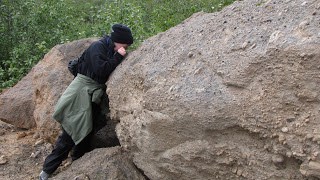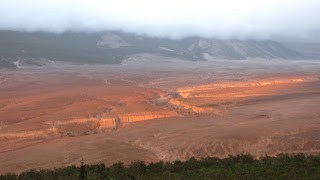It’s Sunday morning, a week since Minnesota Sue departed Brooks Camp and my first day off after an eight-day working stretch. And of course it’s raining. It rained all night. The clouds do actually clear once in a while, though. I got to see the full moon the other night, around 10:30. Since Brooks Camp faces east the moon was reflecting a shimmering sliver of silver on Naknek Lake. A planet was rising slowly and brightly just above the horizon and beneath the moon – probably Saturn or Jupiter, since it wasn’t the small red disc of Mars and Mercury would not have been rising that late. Mercury always is seen close to the sun – it will rise early just before sunrise and set just after sunset.
It actually gets dark here at night now on the Alaska Peninsula, unlike earlier in the season when evening would fade to twilight and just seem to pause there for a few hours while I slept. Then around 5 a.m. it would be almost broad daylight again. It never really got dark. We are over 2 months past the summer solstice, and light turns to dark more easily now at this north 58° parallel.
When I was planning the backpack into the Valley with Minnesota Sue, I had hoped we would see at least one night sky full of stars. Earlier in the season it never got dark enough to see the stars very well, and as it turned out Sue and I never got to see any stars at all in the Valley because of the heavy cloud cover the entire time we were out there.
So this brings us back to the melted pants. Sue had laid a pair of hiking pants on a heater that was not supposed to kick on during the night. There are 2 propane tanks outside the building to run the heater as needed, but anytime I have been out to Three Forks there has been no heat nor has the pilot light been on. So I was totally surprised that the heater would even kick on at all.

Later that morning the 4 guys from Holland came around, and we showed them the melted pants. They hadn’t been aware of any of our ruckus during the night but only heard the howling winds. We chatted easily about their adventure in the Valley, language differences, the euro and the European Union, and of course geology. One of the fellows thought that perhaps one day there would be one global currency along the lines of the euro. I found it hard to believe that people in the U.S. would ever go for that idea, and he said that it would not happen in our lifetimes but that one day in the future it could be a possibility. It was an interesting perspective from a European.
So it was on this overcast morning at the Three Forks visitor center that Sue and I decided on a change of plans. Our comfort level with the weather was marginal and Sue was having trouble with her backpack from the beginning. We just didn’t feel like turning our quest to see Novarupta into a battle with the late summer Alaska elements. So instead we would do 2 day hikes and catch a ride in 2 days back to Brooks Camp. This first day, Tuesday, we would take the trail down to the confluence of Windy Creek/River Lethe/Knife Creek and then Ukak Falls, geologizing to our hearts’ content. Wednesday we would head out the Windy Creek trail into the Valley, geologizing again along the same route we would have backpacked and the same route I did a month or so ago to the 5-mile campsite.

Ukak River and Minnesota Sue on the trail to the confluence
Our early breakfast of Pop-tarts and fruit cocktail didn’t last long, so after an early lunch at 11:00 we headed down the trail to Ukak Falls. This is the same trail that the Valley Tour visitors take except we were able to spend hours longer there, toodling around and stopping at every rock and viewpoint. We discovered paleo-channels in the walls of the ash cliffs, where, between 1912 and now, the rivers coming off the glaciers of the Kejulik Mountains in the Aleutian Range have followed a course and dropped their load of gravels before cutting a new channel through the welded ash that is the Valley of Ten Thousand Smokes. We examined the granites that had been transported down (by gravity and glaciers) from the Aleutian Range batholith (magma that had crystallized underground, forming a massive body of igneous rock which is at least 100 square kilometers in size) – quartz, feldspar, and probably pyroxene were the most obvious minerals we saw with our hand lenses. The ash cliffs have been cut by wind and water into hoodoos, tall spires in spindly shapes that remind many visitors of Bryce Canyon in southwest Utah. We scratched at the lithic tuff – rocks and boulders of welded ash eroded from the cliffs and containing rock fragments and many smaller crystals of mostly feldspar and quartz and pyroxene. In the cliff walls could be seen the fossil fumaroles or steam vents, oxidized remains of minerals in the groundwater that had turned to steam as the 2000° F ash from Novarupta blasted its way down the once lush and green Valley.
We could see Baked Mountain and (with binoculars) the USGS hut in the distance from the confluence, and I realized that this was most likely as close as I would get to seeing the hut this time around. The mountain stood out white against the dark clouds, like a beacon that seemed to be telling me “Here I am. You know where to find me the next time you try.”

Minnesota Sue examining lithic tuff

Novarupta Nina at the confluence of Windy Creek/River Lethe/Knife Creek

Novarupta Nina at Ukak Falls
That night Sue and I sat on benches at one of the tables in the front room of the visitor center and played rummy as the setting sun broke through the clouds from the west, casting its golden glow on the river-carved canyons of ash far down in the Valley. Ever so slowly the light faded once more and I brought out my candle lantern so we could play a few more hands of cards, nibbling chocolate and sipping the wine that never did find its way into our backpacks.

Sunset in the Valley of 10,000 Smokes
The next morning we set out on the Windy Creek trail, to go as far as time would allow since Kent would be arriving at 7:30 that evening to drive us back to Brooks Camp. Luckily at last it wasn’t raining, there was a light breeze with mostly solid overcast, and best of all there were hardly any mosquitoes or black flies to annoy us. At Windy Creek we exchanged boots for sandals for the crossing and took the all-important ‘feet photo” on the other side as proof we had crossed the knee-deep current. I wished the weather had been more cooperative for us to backpack, but that just put me in mind of the old saying “Wish in one hand…” So again we took what Alaska had to offer us and carried on.
I pointed out fossil fumaroles to Sue, this time not in the ash cliffs but on the ground. We stood around a lone piece of pumice the size of a grapefruit and from the distribution of sediment surrounding it tried to determine the direction of the prevailing winds. We talked about deflation which is the sorting, lifting, and removal of fine-grained particles by the wind and how observing this phenomenon can help determine the wind direction. We checked out much pumice along the trail, of course, and then ate our lunch out of the wind in a dry shallow drainage dropping off the Buttress Range.
We talked a bit as we walked about the disappointment of not reaching Novarupta, about the weather that affected our decision not to go, and how we just didn’t want to turn our days into a battle with the elements. Alaska brings out a heightened need for safety in me. True, we were a little gun-shy, too, remembering the German hiker who had been lost last month and presumed drowned in the Valley. Our days in the Valley were before the NPS plane went down last week. I find it critical to be prepared, both mentally and physically, and if I am going to be hiking in a possible gale-force headwind that can also rip my tent to shreds, I need to be totally ready, to have no doubts about my strengths. So we called it good and live with that. Several people I work with go out to the Valley alone, but I am not one of them. If I come back to Katmai next year I will know more what to expect of Alaska and myself. I know where Novarupta is, and I will know how to get there.






